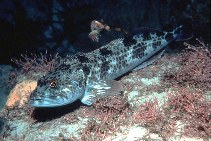| Family: |
Hexagrammidae (Greenlings), subfamily: Ophiodontinae |
| Max. size: |
152 cm TL (male/unsexed); max.weight: 59 kg; max. reported age: 25 years |
| Environment: |
demersal; marine; depth range 0 - 475 m, oceano-estuarine |
| Distribution: |
Northeast Pacific: Shumagin Islands in the western Gulf of Alaska to Ensenada, Baja California, Mexico. Possibly occurring in the Bering Sea (Ref. 6793). |
| Diagnosis: |
Dorsal spines (total): 24-27; Dorsal soft rays (total): 21-24; Anal spines: 3-3; Anal soft rays: 21-24; Vertebrae: 55-59. Anal spines of adults buried in flesh, third spine closely applied to first ray (Ref. 6885). Head without scales; fleshy cirrus above each eye; large mouth; maxilla reaching almost to vertical from posterior margin of eye. Jaws with small pointed teeth interspersed with large fanglike teeth (Ref. 48751). |
| Biology: |
Ranges from the intertidal to 475 m depth (Ref. 6793). Adults are found near rocks, inshore and to 427 m (Ref. 2850). Young occur on sand or mud bottom of bays and inshore areas (Ref. 2850). Both migratory and non-migratory populations exist (Ref. 6885). Adults feed mostly on other fishes but also take crustaceans, octopi and squid (Ref. 4925). Young feed on copepods and other small crustaceans (Ref. 6885). A very important sport and commercial species (Ref. 2850). The liver is rich in vitamin A (Ref. 6885). Marketed fresh and frozen; eaten steamed, fried, broiled, boiled, microwaved and baked (Ref. 9988). Has sharp teeth and gill rakers that can cut fingers if handled. |
| IUCN Red List Status: |
Not Evaluated (N.E.) Ref. (130435)
|
| Threat to humans: |
traumatogenic |
Source and more info: www.fishbase.org. For personal, classroom, and other internal use only. Not for publication.
